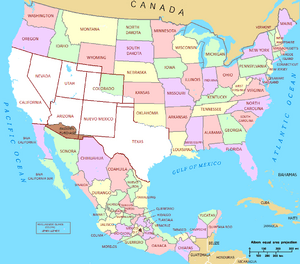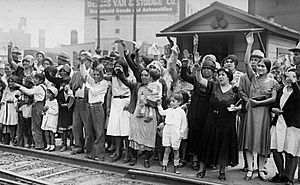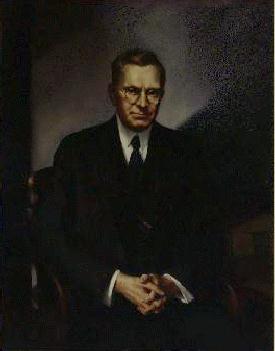Mexican Repatriation facts for kids
The Mexican Repatriation (Spanish: Repatriación mexicana) was a time when many people of Mexican descent were sent back to Mexico from the United States. This happened during the Great Depression, a tough economic period between 1929 and 1939. Around 355,000 to 1 million people were sent away.
Some experts believe that the large number of people sent back between 1929 and 1933 was part of a plan by President Herbert Hoover. He blamed Mexicans for the lack of jobs during the Great Depression. He wanted to free up jobs for other Americans. When Franklin D. Roosevelt became president, fewer people were sent back. His government was also kinder to Mexican immigrants, especially those who had lived in the U.S. for a long time.
A large number of those sent to Mexico, about 40 to 60 percent, were actually U.S. citizens. Most of these were children. The U.S. federal government supported these actions. But local city and state governments often organized the actual deportations. Many people also chose to leave voluntarily. They hoped to escape the economic problems of the Great Depression. The U.S. government officially deported at least 82,000 people. Most of these deportations happened between 1930 and 1933. The Mexican government also encouraged people to return by promising them free land.
Many things made people move to Mexico. These included poverty, job loss from the Depression, threats from U.S. officials, and promises from the Mexican government. Mexicans were often blamed for the economic problems. This was partly because they lived close to the Mexican border. Also, many had distinct physical features and lived in easily recognizable neighborhoods called barrios. Some legal experts say this event was a form of "ethnic cleansing."
Contents
Mexicans in the U.S. Before the Great Depression

Before the Great Depression, people of Mexican descent lived in the U.S. for two main reasons. Some lived in areas that became part of the U.S. after a war. Others moved to the U.S. from Mexico.
How Land Changes Brought Mexicans to the U.S.
The U.S. won the Mexican–American War. Because of this, and other land deals like the Gadsden Purchase and the annexation of Republic of Texas, Mexico gave up a lot of its land. This land became parts of states like California, Nevada, and Texas.
About 80,000 to 100,000 Mexican citizens lived in these areas. The Treaty of Guadalupe Hidalgo, which ended the war, promised them U.S. citizenship. About 3,000 people chose to move to what remained of Mexico. Those who stayed became U.S. citizens. The U.S. census counted them as "white" until 1930. But as more immigrants arrived and racism grew, a new category was created for them in the 1930 census.
Why People Moved from Mexico to the U.S.
Many Mexicans started moving to the U.S. when railroads were built. These railroads offered jobs and made travel easier. Also, U.S. farms needed more workers. The Mexican Revolution (1910-1920) and the Cristero War (late 1920s) caused violence and economic problems in Mexico. This made many people leave their homes.
Records show that about 200,000 Mexicans settled in the U.S. between 1901 and 1920. Another study suggests about 500,000 Mexicans entered the U.S. in the 1920s.
American employers often encouraged Mexicans to come. At the start of the 1900s, U.S. companies even asked the Mexican president to send more workers. They hired people to find Mexican workers for jobs in factories, railroads, and farms. This led to Mexican communities forming outside the Southwest, in places like Indiana and Michigan.
- For example, The Inland Steel Company in Chicago hired many Mexicans. They made up 18 percent of its workers.
These large numbers of immigrants worried some lawmakers. Texas farmers told a committee that some workers brought their families. They reported that 30 percent of workers had families with them.
Earlier waves of immigration also led to people returning to Mexico. This often happened during economic slowdowns. During the Panic of 1907, the Mexican government helped some Mexicans in the U.S. return home. In the Depression of 1920–21, the U.S. government was told to deport Mexicans. This was to ease the burden on charities helping families.
U.S. Citizenship and Immigration Rules
Formal rules for Mexican immigration started with the Immigration Act of 1917. But these rules were not always strictly followed. Employers often got special permissions. In 1924, the United States Border Patrol was created. This made enforcement stricter. By the late 1920s, before the stock market crash, rules became even tighter. This was part of a general anti-immigrant feeling.
Because rules were not always enforced, many citizens, legal residents, and immigrants did not have official papers. Some lost their documents, and others never applied for citizenship. Prejudice also played a role. Mexicans were often seen in a negative way. Many Mexicans did not apply for citizenship because they felt they would still be treated as "Mexican" by others, even if they became citizens.
Sending Mexicans Back in the Early 1930s
Many Mexican nationals and Mexican-Americans were sent back to Mexico in the early 1930s. This happened after the Wall Street Crash of 1929. The crash led to more poverty and strong anti-immigrant feelings. President Herbert Hoover called for deportations. Also, a magazine called The Saturday Evening Post published articles about Mexicans being inferior. Many people chose to return to Mexico voluntarily. This was more common than official deportations.
How Many People Were Sent Back?
It is hard to find exact numbers for how many people were sent back. One estimate says over 400,000 Mexicans left the U.S. between 1929 and 1937. The highest number was 138,000 in 1931. Mexican government sources suggest over 300,000 were sent back between 1930 and 1933. Mexican news reported up to 2 million during a similar time. After 1933, the number decreased but was still over 10,000 most years until 1940.
One researcher, Arturo Rosales, estimates 600,000 people were sent back between 1929 and 1936. Another, Joseph Dunn, concluded that 1.8 million had been sent back. Brian Gratton estimates 355,000 people moved to Mexico from the U.S. in the 1930s. About 38% of them were U.S. citizens born in the U.S. The government officially deported around 82,000 Mexicans from 1929 to 1935.
This was a big part of the Mexican population in the U.S. One estimate says that by 1932, one-fifth of Mexicans in California were sent back. Between 1931 and 1934, one-third of all Mexicans in the U.S. were sent back. The 1930 United States Census reported 1.3 million Mexicans in the U.S. But this number might not be exact. Some people had already left, and undocumented immigrants were not counted.
The return of people to Mexico did not happen equally everywhere. Mexicans living in the U.S. Midwest were only 3% of the total Mexican population. But they made up about 10% of those sent back. This event was so common that it was even mentioned in Mexican popular songs called corridos.
Reasons for Sending People Back
Even before the stock market crash, many groups wanted to limit Mexican immigration. These included farmers, labor unions, and people with racist views. They argued that Mexicans took jobs and cost too much in public aid. These arguments continued during the Great Depression.
For example, in Los Angeles, a spokesperson named C.P. Visel wrote to the government. He said deportations were needed because "We need their jobs for needy citizens." A county supervisor, H.M. Blaine, said that most Mexicans in Los Angeles were on welfare. Similarly, Congressman Martin Dies Jr. wrote that a "large alien population is the basic cause of unemployment." Groups like the American Federation of Labor (AFL) also thought sending Mexicans away would create jobs for U.S. citizens. Secretary of Labor William N. Doak also said deportations were "essential for reducing unemployment."
Not everyone agreed with these ideas at the time. A study in El Paso, Texas, found that deporting non-citizen parents would cost more. This was because their U.S.-born children and wives would then need welfare. Modern studies also suggest that deportations did not help the economy much, or even hurt it.
Racism was also a big reason. Mexicans were targeted partly because they lived near the border. Also, many had distinct physical features and lived in easily identifiable neighborhoods.
Because of these reasons, the federal government worked with local governments to remove Mexicans. The federal government created a "climate of fear." Local groups encouraged people to return through promises, persuasion, and force. Mexican officials also wanted to bring back their citizens. They hoped to use the agricultural and industrial skills Mexicans learned in the U.S.
Early Voluntary Returns
Mexicans were often among the first to lose their jobs after the 1929 crash. Many chose to return to Mexico because of this and constant harassment. For example, in 1931, people in Gary, Indiana, asked for money to return to Mexico. Some took advantage of cheaper train tickets. By 1932, forced returns became more common. Local governments and aid groups in Gary started using "repressive measures" to make people leave. In Detroit, a Mexican national reported that police dragged him to the train station against his will. Mexican Consulates across the country received complaints of "harassment, beatings, heavy-handed tactics, and verbal abuse."
Federal Government Actions
As the Great Depression worsened, feelings against immigrants grew. The Mexican community suffered greatly. States began passing laws that required all public employees to be U.S. citizens. Employers could face fines or jail time for hiring immigrants. Even though this law was rarely enforced, employers used it as an excuse not to hire Mexicans. This made it hard for any Mexican, citizen or not, to find work.
The federal government also put limits on immigrant labor. Companies that worked for the government could not hire immigrants. Many large companies followed this rule. As a result, many Mexican employees were fired, and few new ones were hired. This caused unemployment to rise among Mexicans.
President Hoover publicly supported Secretary of Labor Doak. Doak wanted to add more agents to deport 500,000 foreigners. Doak's plans included watching labor protests. He would label protesters as possible troublemakers or communists. Protest leaders would be arrested and charged with being undocumented. This made them subject to quick deportation.
According to Brian Gratton, the federal government's main role was through deportations between 1930 and 1933. About 34,000 people were deported during this time.
Repatriation in Los Angeles
Starting in the early 1930s, local governments began repatriation programs. These were often run by welfare offices or charities. Los Angeles had the largest Mexican population outside of Mexico. Their deportation approach was typical. They would announce a deportation campaign with publicity. Then, they would make some arrests with "all publicity possible and pictures." Police and sheriffs would help. This led to complaints from the Mexican Consulate and local Spanish newspapers.
The raids were very big. They were like "full-scale paramilitary operations." Federal officials, county sheriffs, and city police worked together. They would raid public places and then force people onto trains or buses. One person described "women crying in the streets when not finding their husbands" after these raids.
Some Los Angeles raids involved rounding up hundreds of Mexicans. Immigration agents and deputies would block off all exits to Mexican neighborhoods. They would drive around with sirens, telling people to surrender.
After the peak of the repatriation, Los Angeles again threatened to deport "between 15,000 and 25,000 families" in 1934. The Mexican government took this threat seriously and prepared for many people to arrive. But the city did not carry out this threat.
Legal Process of Deportations
If someone was caught, they could ask for a hearing. But immigration officers rarely told people about their rights. The hearings were "official but informal." Immigration inspectors acted as interpreter, accuser, judge, and jury. Also, the person being deported rarely had a lawyer. This was only allowed if the immigration officer agreed. This process likely violated U.S. federal rights like due process and equal protection.
If no hearing was requested, the second option was to leave the U.S. voluntarily. In theory, this would allow people to re-enter the U.S. legally later. This was because no arrest warrant or legal record was kept. However, many people were tricked. When they left, they were given a "stamp on their card" that showed they had received charity. This meant they would be denied re-entry because they might become a "public charge."
Later Deportations
The U.S. federal government responded to increased immigration during World War II. This was partly because more farm workers were needed. In 1954, the INS (Immigration and Naturalization Service) started a program called Operation Wetback. About one million people, mostly Mexican nationals without papers, were sent back to Mexico. But some U.S. citizens were also deported to Mexico during this time.
Images for kids








